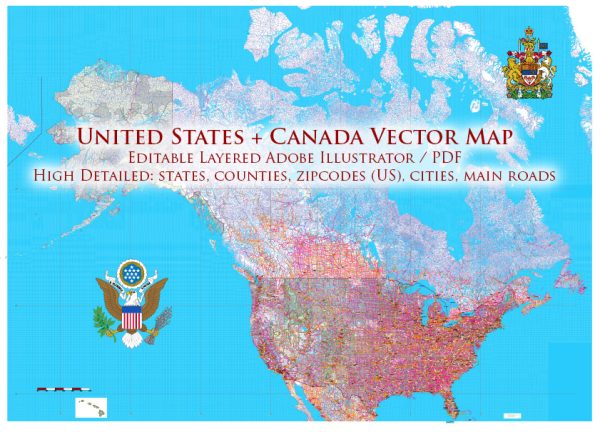The history of railroads in the United States and Canada is a fascinating journey that played a crucial role in the economic and social development of both countries. The development of railroads began in the 19th century and had a profound impact on transportation, industry, and the expansion of territories.
Vectormap.Net provide you with the most accurate and up-to-date vector maps in Adobe Illustrator, PDF and other formats, designed for editing and printing. Please read the vector map descriptions carefully.
United States:
- Early Development (1820s-1830s):
- The idea of rail transportation gained traction in the early 19th century. The first operational railroad in the U.S. was the Baltimore and Ohio (B&O) Railroad, chartered in 1827 and opened in 1830.
- By the mid-1830s, a “railroad boom” occurred, with numerous railroads being chartered and constructed.
- Expansion and Westward Movement (1840s-1860s):
- Railroads played a crucial role in the westward expansion, connecting the East Coast with the West. The completion of the Transcontinental Railroad in 1869, connecting the Central Pacific and Union Pacific Railroads, marked a significant milestone.
- This expansion facilitated the movement of people, goods, and resources, contributing to economic growth and the development of new territories.
- Golden Age of Railroads (Late 19th to Early 20th Century):
- Railroads became the backbone of the U.S. transportation system, linking urban centers and enabling efficient movement of goods and passengers.
- The development of standardized time zones in 1883, known as the “The General Time Convention,” was largely driven by the need for standardized railroad schedules.
- Challenges and Decline (Mid-20th Century):
- The mid-20th century saw challenges for the railroad industry, including competition from automobiles, trucks, and airlines. The decline in passenger rail travel became pronounced with the rise of automobiles and airplanes.
- The government stepped in to address financial struggles, and some railroads went bankrupt, leading to mergers and the formation of larger railroad companies.
- Revitalization and Modernization (Late 20th Century-Present):
- In the late 20th century, efforts were made to revitalize the railroad industry. Amtrak, the national passenger rail service, was established in 1971.
- Freight railroads underwent a significant transformation, embracing new technologies and adopting more efficient operating practices.
Canada:
- Early Railroads (1830s-1850s):
- Canada’s first railroad, the Champlain and St. Lawrence, opened in 1836 in Lower Canada (now Quebec).
- The Grand Trunk Railway, established in the 1850s, played a crucial role in linking major cities in Quebec and Ontario.
- Expansion and Nationalization (Late 19th to Early 20th Century):
- The Canadian Pacific Railway (CPR) was completed in 1885, connecting the East Coast to the West Coast and facilitating the settlement of Western Canada.
- Railways played a vital role in the economic development of Canada, transporting resources like timber, minerals, and agricultural products.
- Nationalization and Modernization (20th Century):
- During the 20th century, some Canadian railways faced financial challenges, leading to nationalization. Canadian National Railway (CNR) was established in 1918 to take over several bankrupt railroads.
- CNR and Canadian Pacific Railway (CPR) continue to be major players in Canada’s rail industry, with a focus on freight transport.
- Modern Railways (Late 20th Century-Present):
- Similar to the U.S., Canada’s railways underwent modernization efforts, adopting new technologies and increasing efficiency in freight transport.
- Via Rail, the national passenger rail service, was established in 1977, providing intercity passenger rail services across Canada.
Conclusion:
The history of railroads in the United States and Canada reflects the dynamic growth, challenges, and adaptations in transportation infrastructure. Railroads were instrumental in connecting regions, facilitating economic development, and shaping the landscapes of both countries. While the role of passenger rail has evolved, freight rail remains a vital component of the North American transportation system.


 Author: Kirill Shrayber, Ph.D.
Author: Kirill Shrayber, Ph.D.